How to Travel from Tbilisi to Shatili & Khevsureti
13 min readA detailed guide to travelling to Shatili from Tbilisi by bus or car.
Khevsureti and Tusheti are two of the most remote (and spectacular) mountain regions in Georgia. One of the main differences between them is that the road to Khevsureti (via the Datvisjvari Pass) is a whole lot tamer – less windy, wider, lower, and generally better kept – than the road to Tusheti (via the Abano Pass).
This makes Khevsureti a much more accessible travel destination.
The road to Shatili varies from beautiful new asphalt to bumpy concrete to gravel. It is far from an easy drive, but it is adequate enough for shared transport in the form of a twice-weekly marshrutka (albeit a beefier 4×4 van) to navigate during the dry summer months.
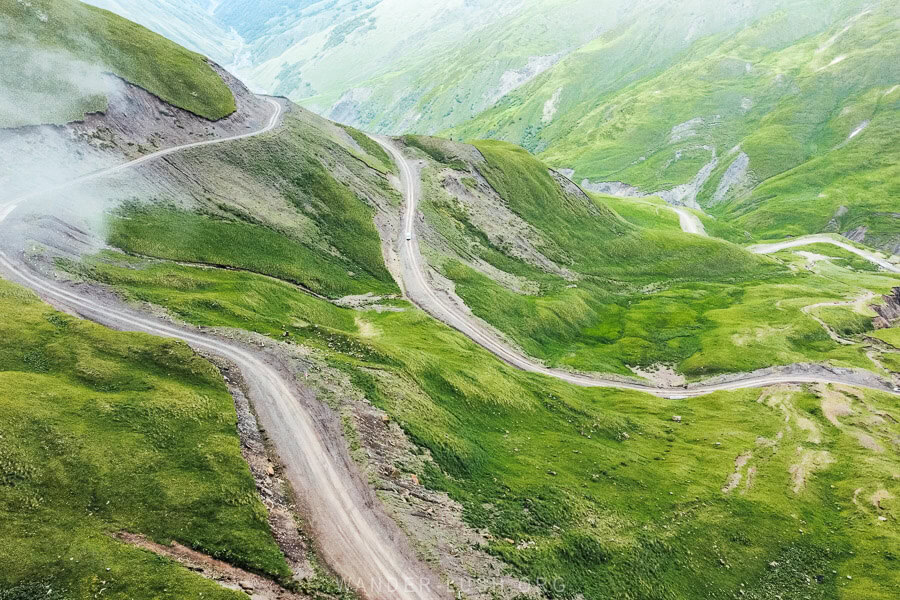
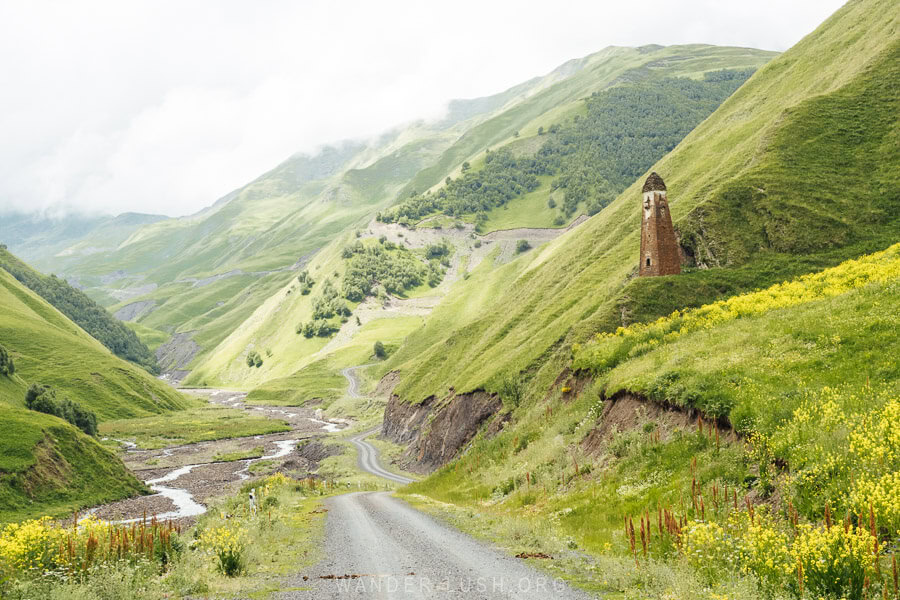
That does not mean that just anyone can drive to Shatili. The road is still challenging, with narrow sections, tight bends, and steep drop-offs. There are no petrol stations, and help is not easy to find. Landslides are a major danger, and in the time that I have lived in Georgia, I have heard of more than one tragic accident involving tourists. As you go deeper into Khevsureti beyond Shatili, conditions get progressively worse.
In this guide, I offer a detailed description of the road to Shatili and share everything I know about the different transportation options that are currently available from Tbilisi.
Please note: This post contains affiliate links, meaning I may earn a commission if you make a purchase by clicking a link (at no extra cost to you). Learn more.
Tbilisi to Shatili distance & travel times
Shatili is located 150 kilometres (93 miles) north-east of Tbilisi. There is only one road into Khevsureti, a mountain road that traverses the Datvijvari or Datvisjvari (‘Bear Cross’) Pass at 2,600 metres above sea level.
Travel time from Tbilisi to Shatili is a bit longer than Google Maps predicts. It takes a minimum 4 hours to reach Shatili from the outskirts of Tbilisi (plus however long it takes you to get out of the city centre, depending on your departure point).
Here are the approximate travel times for Khevsureti:
- Outskirts of Tbilisi to Korsha: 1.75 hours
- Korsha to Roshka: 40 minutes
- Korsha to the Datvisjvari Pass: 50 minutes
- Datvisjvari Pass to Shatili: 1.5 hours
- Shatili to Mutso: 45 minutes
- Mutso to Khonischala: 20 minutes
Important note: If you are making a detour to the village of Roshka for the Abudelauri Lakes Hike, note that it is marked incorrectly on Google Maps. The true location of the village is here.
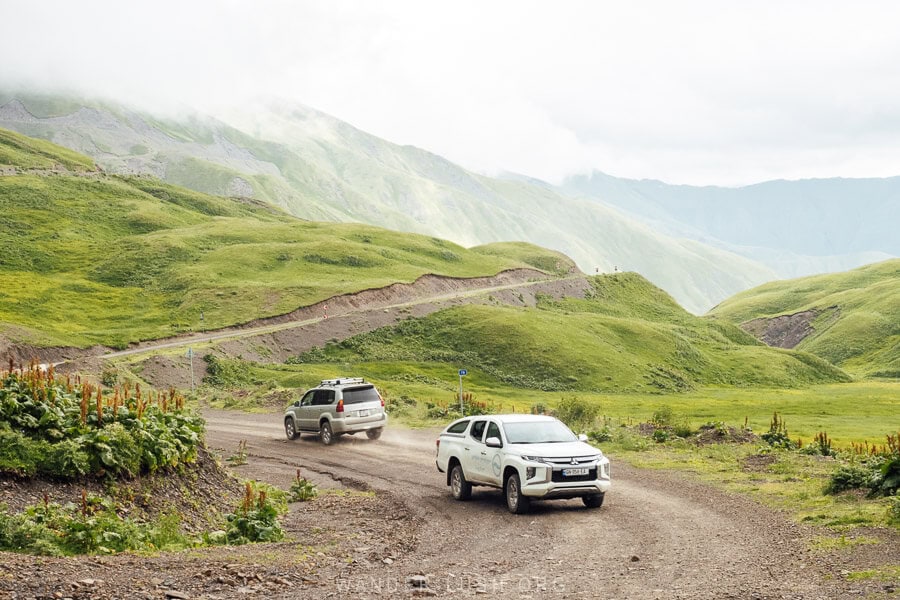
What is the road to Shatili like?
As I mentioned, the drive to Shatili is a lot less treacherous than the drive to Tusheti. I am a nervous passenger generally (and I don’t love heights), but I did not find the drive to Khevsureti too bad.
Road conditions vary from a beautiful new asphalt road to a gravel road that is narrow in places and falls steeply away into the river.
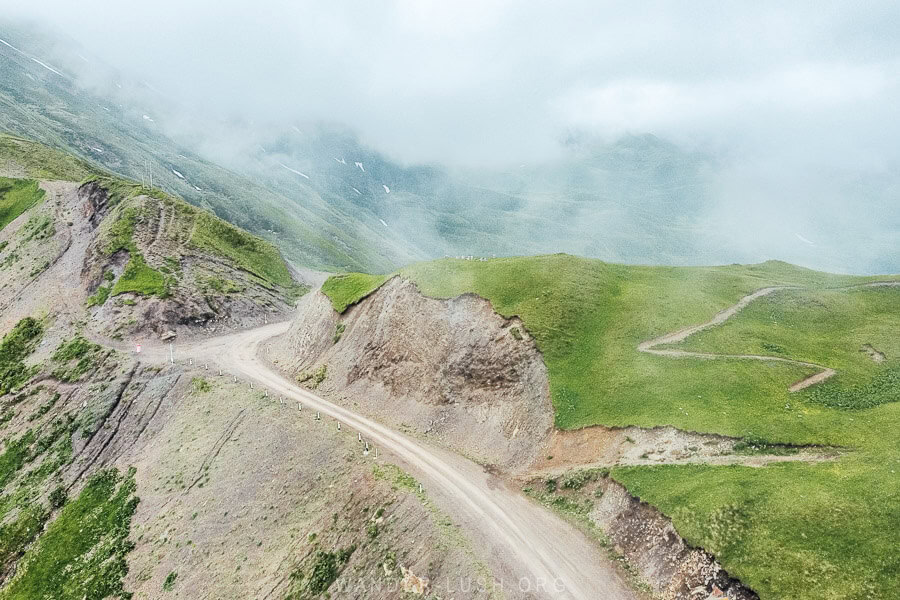
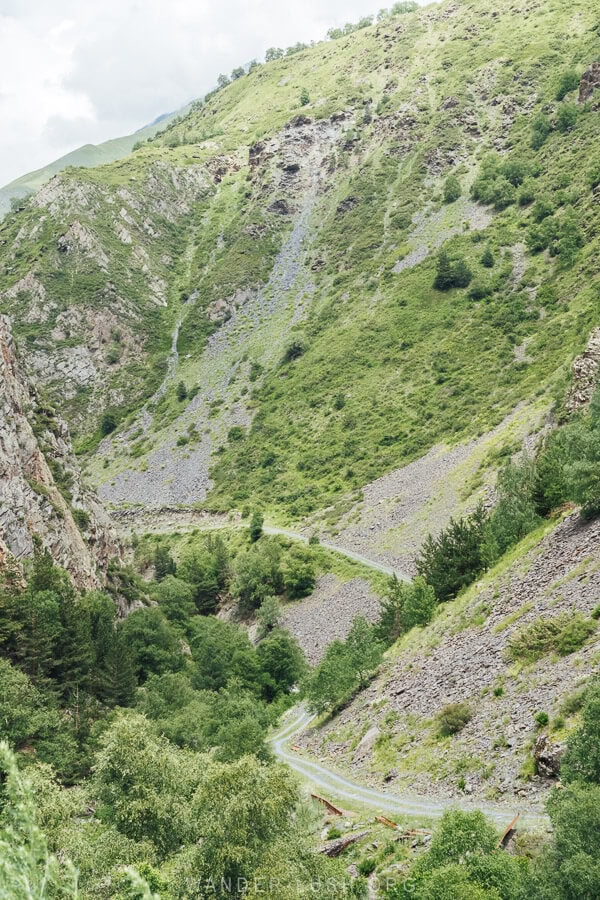
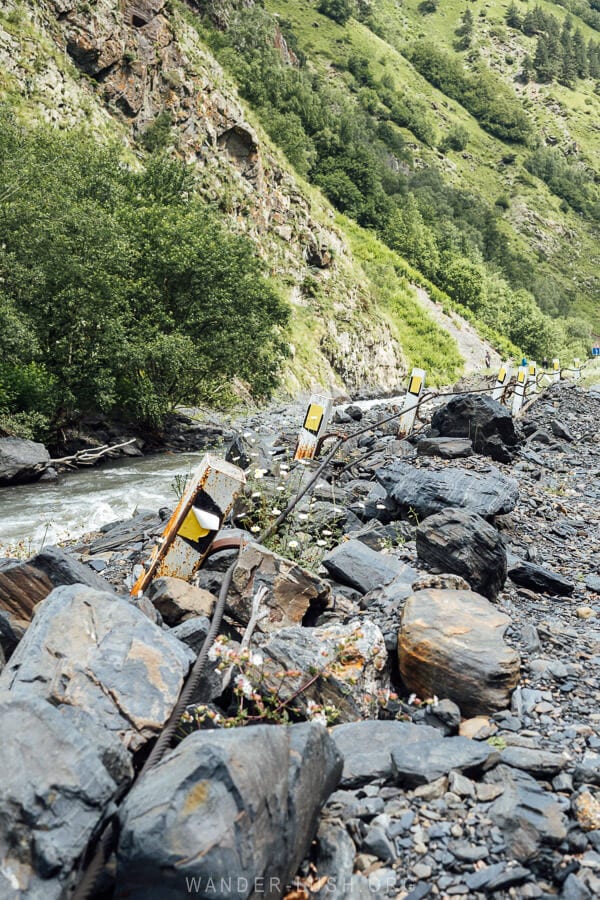
The first part of the drive takes you out of Tbilisi via the Georgian Military Highway. This section of the Military Road is well-maintained and very easy to navigate. Instead of continuing along the Military Road towards Kazbegi, you turn off at Zhinvali to follow the eastern branch of the reservoir.
The drive from Zhinvali to Korsha in Lower Khevsureti is pretty straightforward. After Korsha, the road gets steeper as you near the Datvisjvari Pass. On both sides of the pass the road is windy and narrow. There are metal rope barricades along most of the road, and there are big stretches where the road is slipping away and these have fallen into the river.
In Upper Khevsureti, the road between Shatili, Mutso and Khonischala is rougher and more challenging (but not as steep).
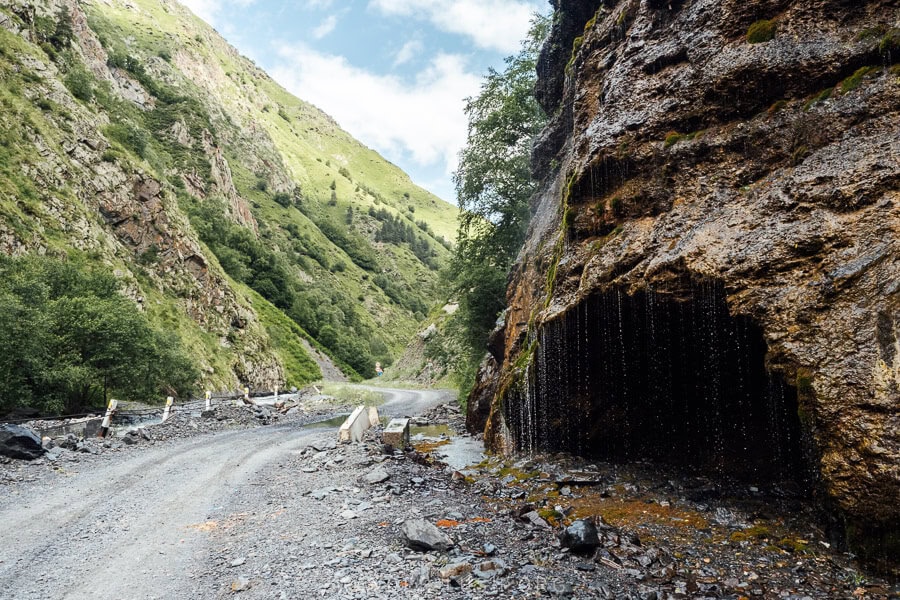
Zhinvali to Korsha: New, mostly flat, sealed asphalt road with clear line markings. At some point the road turns from asphalt to concrete. There are some rough sections/potholes as you near Korsha, but they are small.
Korsha to Roshka: Very rough, muddy off-road track that requires a 4WD. Work was being done on this road at the time of our visit, so I expect it will be gravelled or sealed in the near future.
Korsha to the Datvisjvari Pass: After Ghelisvake outside Korsha, the road turns from concrete to unpaved gravel. It gradually gets steeper and steeper as you near the pass. Some sections are narrow and bumpy.
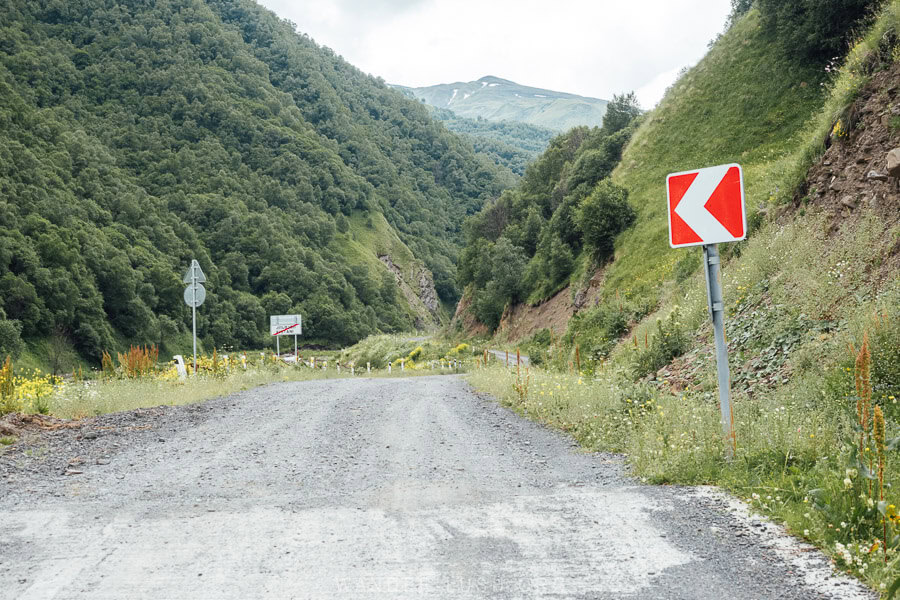
Datvisjvari Pass to Shatili: Continuation of the gravel road, narrow and bumpy in places with a drop-off on one side.
Shatili to Mutso: Continuation of the gravel road, flatter and wider than around the pass.
Mutso to Khonischala/Ardoti: Continuation of the gravel road (bumpier and less well-kept). There is a river crossing at this point (there is a pedestrian bridge but no car bridge) followed by a steep descent into Khonischala.
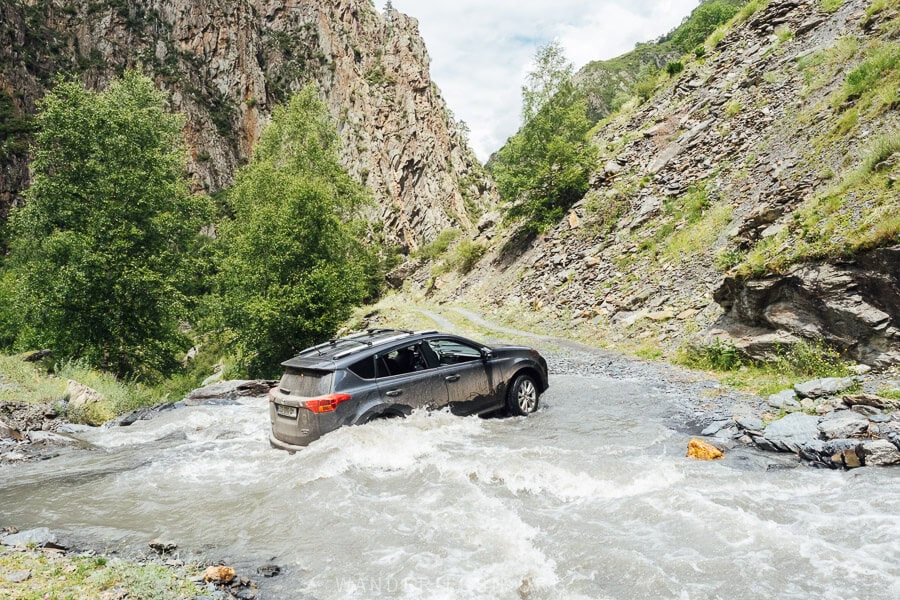
When is the road open?
The road to Shatili is only open during the summer months – approximately from the middle of June until the end of September. The safest months to travel are July and August, when it is less likely to be raining.
Due to the high altitude and snowfall, the road is closed and inaccessible during the winter.
In 2024, the road to Shatili opened in mid-June and the marshrutka van service was available from June 17th.
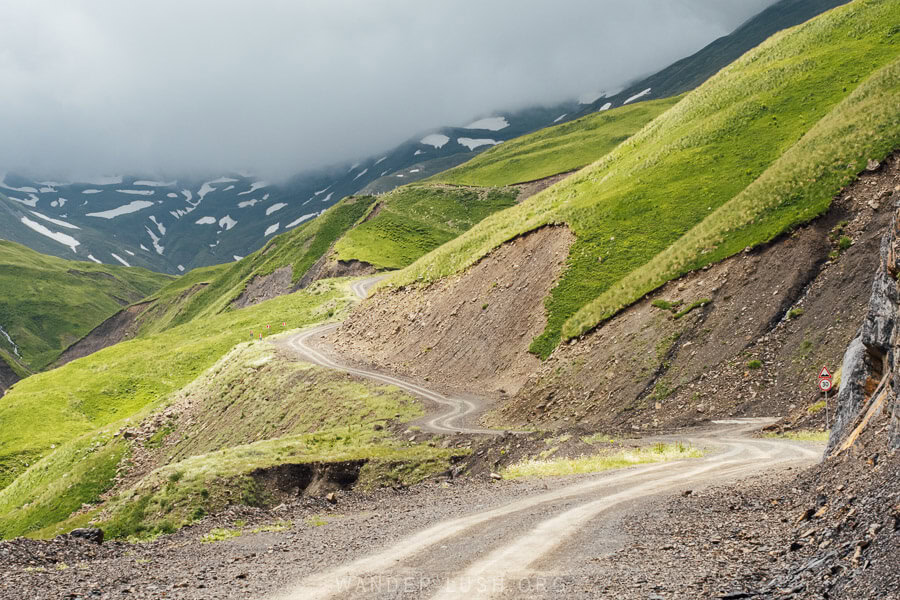
What sort of car do you need?
I recommend visiting Khevsureti with a 4WD with high undercarriage clearance. It might be possible to get to Korsha with a sedan, but you will definitely need something more robust to get up over the pass and into Shatili and Mutso.
How to check the road conditions
This part of Georgia is prone to flash flooding and landslides. There have been several serious accidents on the road in the past couple of years where people got caught off guard by the fast-changing weather.
For this reason, you must check conditions locally before you set off for Shatili. If you are using the marshrutka van or hiring a private driver, they will be on top of the news. If you are self-driving, you should use the Geo Road Facebook Page/hotline to check for any temporary closures or obstructions. You can also ask your guesthouse in Khevsureti to update you on anything important.
It is not advisable to drive to Khevsureti in the days following heavy rain.
How to get to Shatili from Tbilisi: 4 options
Option 1: Tbilisi to Shatili marshrutka
There is a regular scheduled bus service between Tbilisi and Shatili during the summer season (usually mid-June through to the end of September). Vans depart from Didube Station in Tbilisi twice per week, and return from Shatili to Tbilisi twice per week.
The timetable tends to remain the same year to year and is currently as follows:
Tbilisi to Shatili:
- 10am Wednesday
- 10am Saturday
Shatili to Tbilisi:
- 12pm midday Thursday
- 12pm midday Sunday
Tickets cost 30 GEL per person, one-way. Travel time is somewhere around 4.5-5 hours depending on traffic in the city and how many stops the driver makes. We saw the Shatili van parked at various locations along the road, so it appears that drivers are happy to make brief photo stops on request.

These are not regular marshrutka vans, but rather Mercedes-Benz Vario 614D 4×4 trucks. The seating arrangement is much the same, but the windows are bigger.
There is space for luggage in the back and under the seats. The vans I saw did not have roof racks, so it might not be possible to bring a big suitcase or oversized item with you. If you have luggage, I recommend arriving extra early to ensure you get a space.
The Shatili vans depart from inside Didube Bus Terminal at the same parking lot as vans to Kazbegi and vans to Mtskheta.
Here is the exact location on Google Maps.
I also show the location of the ticket desk in this Didube Video Tour.
I recommend arriving at least 40 minutes ahead of the scheduled departure time. When you get to Didube, you will see the van with a big Shatili sign on its dashboard (as pictured above). Tickets can be purchased from the small window next to the market (at the location pinned above), or you can pay the driver directly. Cash only (GEL, correct change preferred).
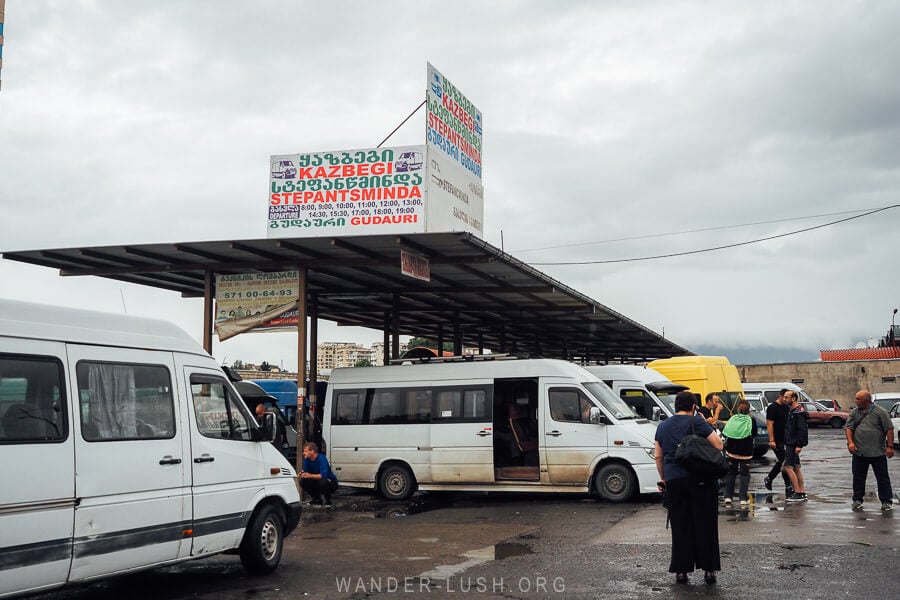
If you are travelling in peak season (July/August), it is a good idea to reserve your seat a few days in advance. The only way to do this is by contacting the driver directly. If you don’t speak Georgian or Russian, the easiest option is to ask your guesthouse in Khevsureti to make the phone call. It’s also a good idea to do this for the return journey.
The drivers contact details are as follows:
- Temuri (Wednesdays & Thursdays): 599 27 29 04
- Irakli (Saturdays & Sundays): 555 40 45 99
You can use this van to travel to any of the villages before Shatili, including Korsha. Just tell the driver where you want to go and he will let you off in a suitable location.
Shatili is very small, so when you arrive you should be able to walk to your guesthouse/accommodation without issue. For the return journey, the bus departs from the riverside near New Shatili.
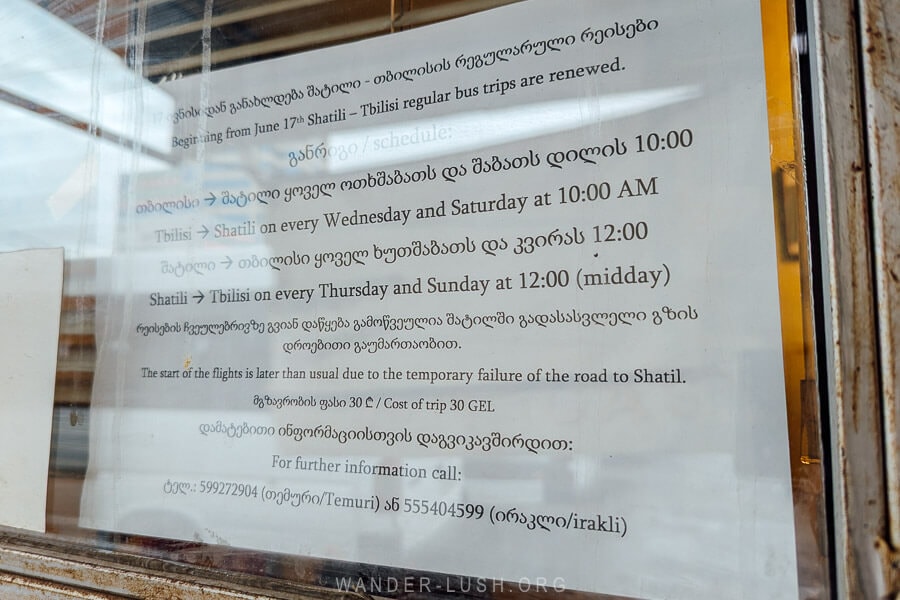
Departing from Shatili, there is no direct onward transportation to other destinations in Georgia. I.e. you need to go back through Tbilisi.
However, if you want to continue your travels in Kazbegi, then you can alight the bus on the highway in Zhinvali and try to pick up a marshrutka van travelling north. I recommend waiting around this service station.
Vans coming up from Tbilisi pass Zhinvali every 60-90 minutes throughout the day. The approximate times are: 9am, 10am, 11am, 12pm, 1pm, 2pm, 3.30pm, 4.30pm, 6pm, 7pm, 8pm.
I definitely do not recommend travelling on these roads after dark. Vans will not stop for you if there are no seats available – and vans during the day will almost always be full.
Alternatively you could pre-book a GoTrip driver to meet you in Zhinvali. There are no drivers based in Zhinvali, so you need to add Tbilisi as your point of origin.
This is also an option if you want to alight in Zhinvali then travel to Kakheti via the backroad through Tianeti. Here is an example GoTrip itinerary (you will need to inform your driver that you are starting from Zhinvali and not from Tbilisi).
The journey to Kazbegi from Zhinvali takes around 2 hours, and the journey from Zhinvali to Telavi takes around 3.5 hours.
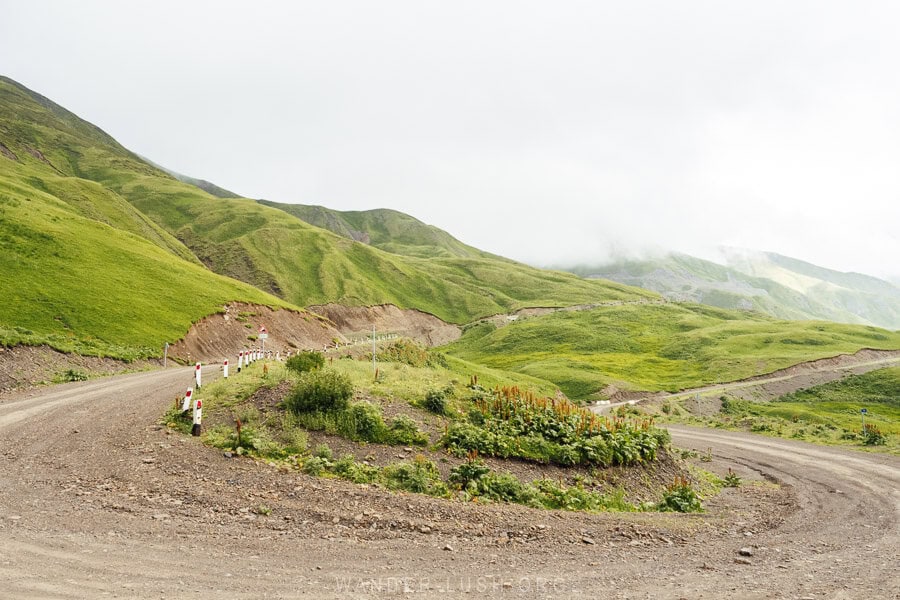
Option 2: Visiting Shatili with a private driver
If you want to travel more extensively around Khevsureti beyond Shatili plus have more flexibility on the drive up to stop for photos, then the better option is to hire a private driver.
We hired a private driver for the full 3 days of our trip. By doing this, we were able to see and do a lot more in a short period of time – including stopping off for the Abudelauri Lakes Hike on the way up to Shatili, and overshooting Shatili to spend a night in the more remote village of Khonischala.
An experienced driver who is familiar with the roads and has the right kind of vehicle is essential. If you need a recommendation, please get in touch via email and I will be happy to refer you to the driver we used for our trip.
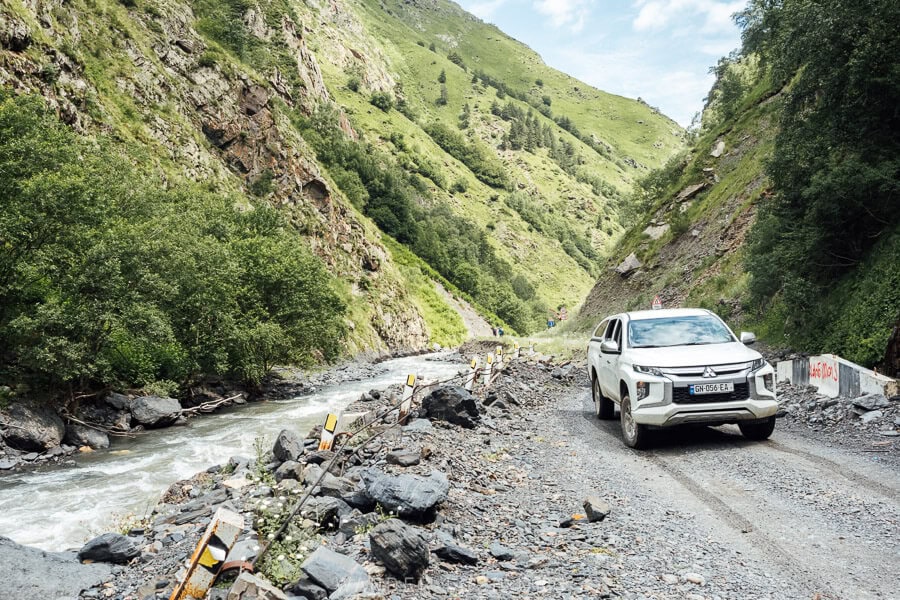
Option 3: Joining an organised tour from Tbilisi to Shatili
I do not recommend visiting Shatili as a day trip from Tbilisi. The drive is too long, and the road is too demanding.
Multi-day tours that are better paced with enough time for the driver to rest in between legs are a safer bet. I have not used this company personally, but a tour such as this one which visits Shatili and Mutso over 2 days would be ideal.
Longer tours such as this one which combines Khevsureti and Kazbegi are also available.
If you are interested in travelling to Khevsureti by foot – another transport option that I haven’t mentioned yet! – then there are also guided multi-day hikes from Omalo to Shatili.
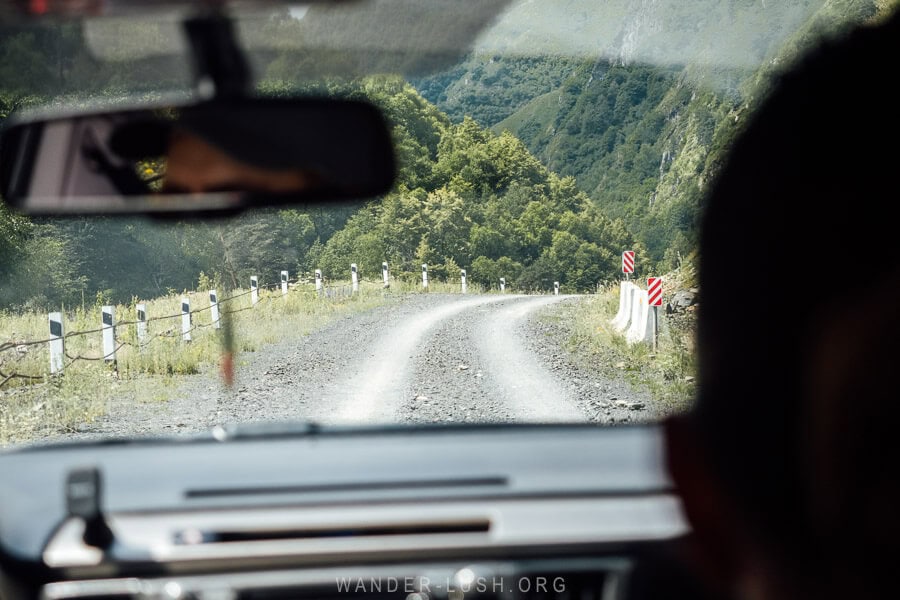
Option 4: Self-driving to Shatili
I only recommend this option for confident drivers who are experienced with off-roading and familiar with driving conditions in Georgia.
It is important to note that because of the road conditions, the majority of car rental companies in Georgia prohibit you from taking their cars to Shatili. Offroad vehicles from Martyna z Gruzji (available to pick up in Tbilisi or Kutaisi) can be taken to Shatili. Mention wanderlush when you book to receive 10% off.
There are no petrol stations in Khevsureti, so you need to take all the fuel you need with you. There is one auto service shop before the pass in Barisakho. If you run into car trouble, you should be equipped to troubleshoot any issues yourself.
Google Maps is sufficient for navigation, but there is no mobile service for most of the drive. Remember the Roshka location is incorrect on Google Maps, and travel times quoted are a bit off (always add an extra 20-50% to what Google Maps predicts). Always check weather conditions and potential road closures before you set off.
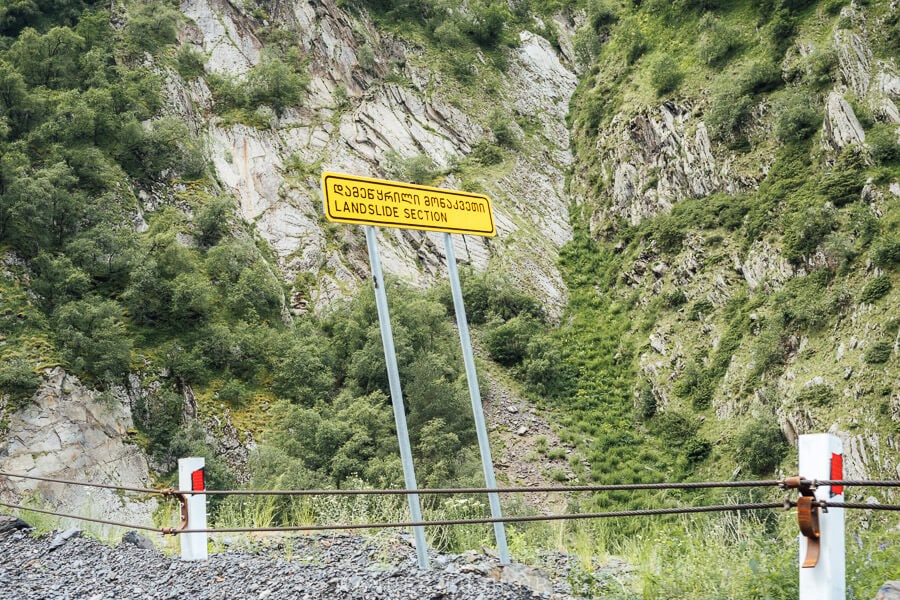
Where to stop on the way from Tbilisi to Shatili
The drive to Shatili through the Caucasus mountains is incredibly scenic. I wanted to stop at every turn for a photo (but I’m a good passenger, so I held back!).
There are half a dozen specific points of interest to see along the way. Having a private car for at least one leg of the journey is essential if you want to fit all these stops in.
For full details on these destinations and places beyond Shatili, see my 3-day Khevsureti travel itinerary.
Pshauri Balada
Pshavi (another historic mountain region that you pass through between Zhinvali and Khevsureti) is famed for its khinkali dumplings. There are half a dozen khinkali specialty restaurants located along the road in the villages of Kalilo and Sharakhevi.
If the timing is right, I highly recommend stopping here for lunch. We had a feast of kalakuri-style dumplings and dambalkhacho (aged cheese) at Pshauri Balada.
The Vazha-Pshavela House Museum
Located in Chargali, a short detour from the main road, the Vazha-Pshavela House Museum is dedicated to the legendary Georgian poet who was born here. The architecture of the 1961-built museum building is very interesting. Note that the museum is closed on Mondays.

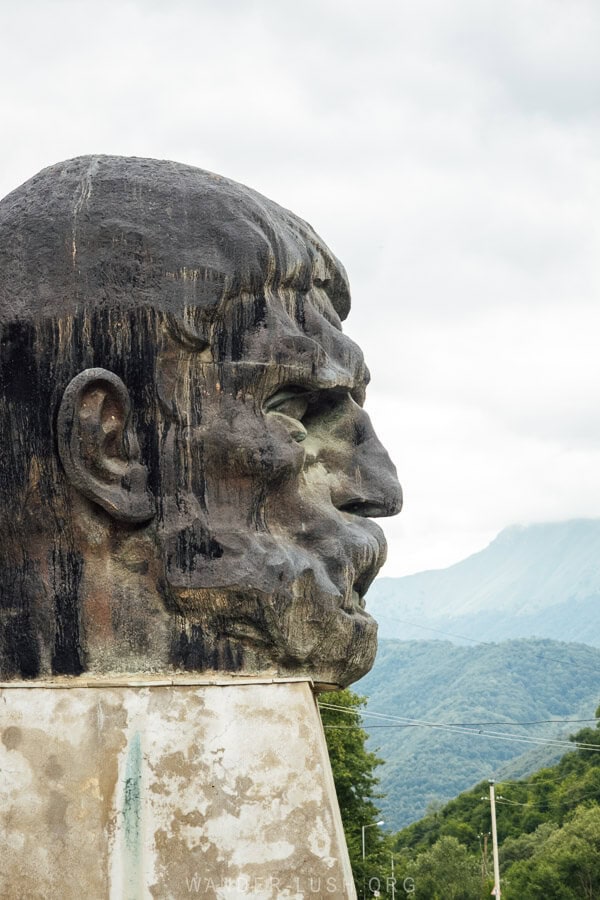
Korsha village
Home to the famous Korsha Guesthouse, this small village is one of the first you encounter after entering Khevsureti proper. Korsha has a small Ethnography Museum located inside a reconstructed stone tower (ask at the guesthouse to be let in).
The Datvisjvari Pass
The highest point of the drive, the Datvisjvari or ‘Bear’s Cross’ Pass is located 2,600 metres above sea level. There is room to safely park the car and walk around to see the small shrines and viewpoints. It’s also possible to walk further up the ridge to the highest point of the pass, where there is a three-pronged metal cross.
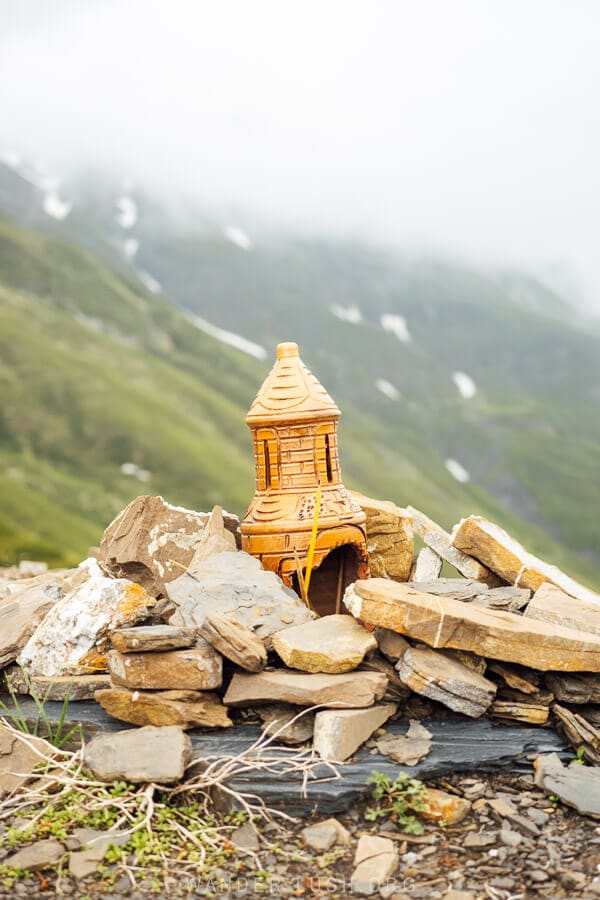
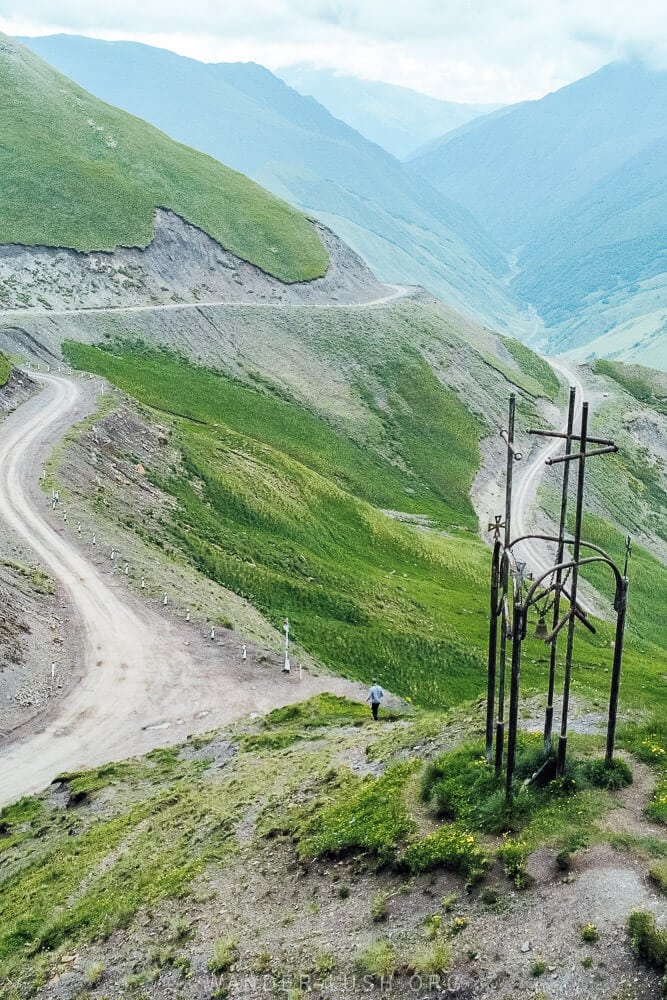
Lebaiskari Tower & Kistani Fortress
Located in valleys off the eastern side of the road as you approach Shatili, Kistani and Lebaiskari are two long-abandoned Khevsur villages.
Lebaiskari Tower is a great example of a Vainakh-style tower, which has a tapered silhouette and is topped with a little shale roof. This sort of architecture is prevalent across this part of the Caucasus and can also be found in Chechnya and Ingushetia.
Kistani Fortress is a set of two ruins perched atop green hills. With a stony river flowing at its feet and big leafy trees dotted along the valley, it is incredibly picturesque.
Guro’s Tears
Guro’s Tears is an unusual waterfall and shallow cave located right on the roadside just before Shatili. The mossy rock wall perpetually drips with spring water. I did not get the Google pin for this one (there was no service on the road) but it’s impossible to miss.
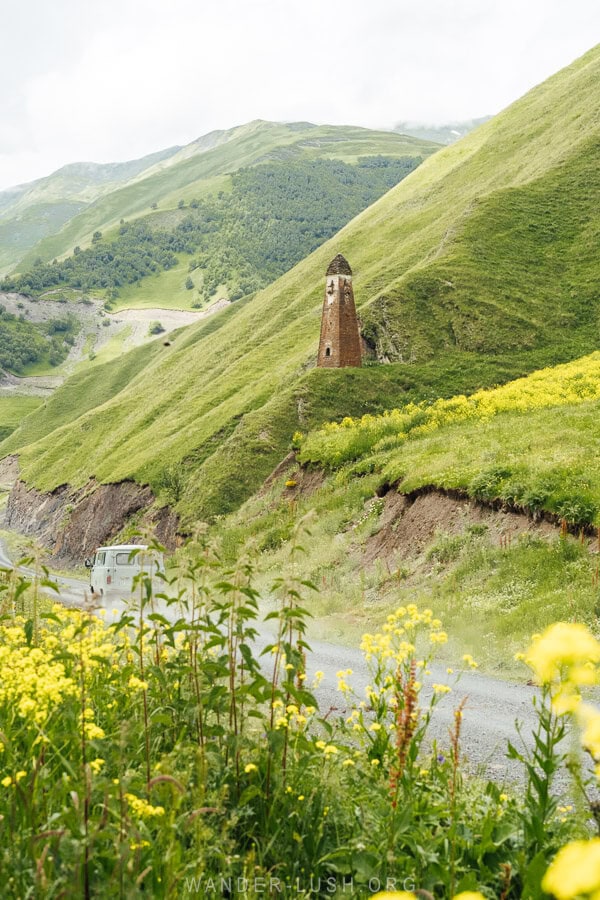
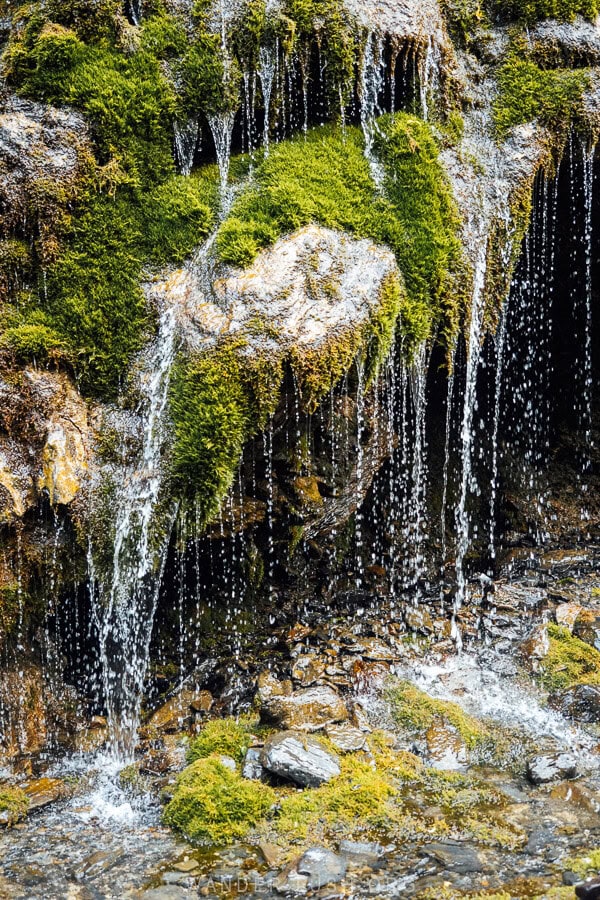
How to get around Khevsureti (Shatili to Mutso, Ardoti, etc.)
The van from Tbilisi only goes as far as Shatili. There is no regular public transport between the villages in Khevsureti. If you travel to Shatili by bus, then you will need to organise a driver to take you to Mutso and/or Khonischala/Ardoti. Anatori can be reached on foot.
Similarly, if you decide to stay in Lower Khevsureti in Korsha, you will need a taxi to get to Roshka and the Abudelauri Lakes trailhead.
The best way to organise transport within Khevsureti is by asking at your guesthouse. See my recommendations below.
Where to stay in Shatili
Top choice: Ethnic Hostel
Managed by the charming Irma and her family, Ethnic Hostel (less of a hostel and more like a guesthouse with a shared bathroom) is set inside a reconstructed tower-dwelling adjacent to the main village. We tossed up between this hotel and Front Castle, but decided on Ethnic in the end because of the view: from the rooftop terrace you can see all of Shatili, rather than being inside the village with not much of a view. Not to mention that prices at Front Castle were almost double.
We booked all three rooms – the double, twin and a room with a bunk that sleeps three. The tree-trunk bed frames and all the rest of the furniture was handmade by Irma’s husband. Rooms are very quiet, clean and comfortable, and the breakfast is great.
Check prices & availability here on Booking.com.
Sulphoni
We didn’t stay at Sulphoni, but we did eat dinner here. The owners couldn’t be sweeter. Drop by in the afternoon and they will tell you what’s on the menu for that evening (we had fried potatoes, salad, and one of the best khachapuris of my life).
The single-storey stone house is on the opposite side of the river and a bit further to walk to from the village, but the front-on view of Shatili from the little garden terrace is splendid.
Rooms can be reserved via Airbnb.
Front Castle
Front Castle is located inside the fortress-village on the very edge of the complex. Rooms look much the same as Ethnic Hostel (but without the cool handmade furniture).



